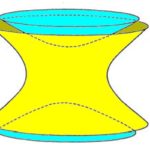Experimenters beware! If you think it might be instructive to dismantle a microwave oven and power up the magnetron to make a space gun, don’t do it. A microwave gun (called a magnetron) in a state other than as manufactured has numerous potential hazards. (Nevertheless, you can find a lot of YouTube videos describing exactly how to teardown a magnetron tube.)

Nevertheless, there is no hazard in reading about and studying this equipment in the abstract, which will lead to an understanding and appreciation of the intriguing concept of cavity resonance.
A cavity resonator is a special case of the resonator device or system, which has a pronounced tendency to oscillate at one or more frequencies, one typically at highest amplitude. These frequencies are determined by mass and dimensions or electrical, electromagnetic, acoustic or other qualities.
A cavity resonator consists of an enclosure in which the dimensions of a hollow space determines the resonant frequency. Multiple resonant frequencies arise when a physical system exhibits more than one degree of freedom. A tuned LC circuit, in contrast, is constrained to a single narrow spectral band. Electronic circuits are not suitable resonators at high frequencies because of attenuation due to even a small amount of parallel capacitance. Instead, microwave transmitters use hollow metal boxes that are part of a waveguide system.
Helmholtz resonators, usually small brass or other metal spheres pointed at the top, are used to receive and retransmit discrete acoustic frequencies selected from broad spectra such as music or some other complex sound. They have small holes in the neck and larger holes at the other end, from which a single tone, based on the resonator’s size and shape is emitted.
A mechanical Fourier sound analyzer consists of 14 separate Helmholtz resonators. It is used to decompose a complex acoustic wave into discrete emissions. An adjustable universal resonator consists of two elements, one smaller than the other. The signal can be altered by sliding the pieces so as to change the enclosed volume.
When air is forced into a Helmholtz resonator or similar physical cavity, as by an acoustic event, the pressure rises until air begins to flow out, eventually creating a series of oscillations which is either sustained or damped out depending upon the ongoing presence of energy at the input. This is classic oscillation, much like a swinging pendulum or an electrical LC circuit.
Automotive exhaust systems consist of mufflers, sometimes two in series. The dimensions are calculated to suppress otherwise high-amplitude engine sounds. Driving along a highway, you can demonstrate Helmholtz resonance by slightly opening a single side window so the car interior becomes a resonant cavity and you hear a whistling sound.
Of course, this behavior is observable in a variety of non-acoustical scenarios. One of the most interesting of these is the cavity laser. This generally consists of a cavity resonator, tuned to a vastly higher frequency. The space is bounded at the ends by two or more mirrors. Light, a form of electromagnetic radiation, is reflected back and forth with little loss, establishing a standing wave within the cavity. A useful coherent beam passes out through one of the mirrors, which is partially reflective and partially transparent.
Many types of optical lasers exist, and they are widely used. They are characterized primarily by the way energy is injected or pumped into the system and the way this energy is used to sustain oscillations. In all optical lasers, the defining element is the optical cavity, containing the gain medium.
Among the many types of optical lasers, the mirrors are spaced at different distances depending upon their focal lengths. Flat mirrors are rarely used due to the difficulty in precisely aligning them. Always, the focal point lies outside the cavity so as to avoid unacceptable temperature rise.
Optical cavities are inherently high-Q devices. With multiple reflections there is little loss, making for a tight, highly collimated beam. Interference among the multiple reflections tends to suppress all but a few distinct frequencies within the resonator.
Laser is an acronym that represents Light Amplification by Stimulated Emission of Radiation. One of the qualities of a laser beam is its coherence, which permits it to be formed into a tighter beam than possible using traditional optical means. The beam remains narrow relative to the distance traversed, a property known as collimation, making it useful in cutting and welding metal as well as projecting bright spots on the moon.
A laser beam that exhibits coherence, in addition to existing at a single frequency, is polarized. Also, it has instantaneous amplitude and phase that do not vary, as opposed to incandescent and fluorescent light and the radiation produced by atomic fusion within the sun and most stars. Here the parameters are random and the light is incoherent.
In laser technology, the term “light” has come to include adjacent frequency emissions including infrared, ultraviolet, X-ray, microwave and gamma ray.
For a laser to operate, inside the cavity it must have an optical medium, which is a material capable of stimulated as opposed to spontaneous emission. Only radiation at one or more specific frequencies is amplified. For this amplification to happen, a pumping process provides energy from outside the cavity. This energy may take any of several forms, most typically electric current or light of some other frequency, sometimes a lamp, sometimes another laser. Thus, laser amplification resembles the amplification of an oscillating signal in a bipolar junction transistor, where power is supplied to a third terminal.
In the optical cavity, light bounces back and forth between two or more mirrors and each time it passes through the medium, its power increases due to the pumped-in energy. Stimulated emission is the converse of spontaneous emission, and an electron may exhibit either of these.
Electrons orbit the nucleus of an atom in discrete shells at specific distances from the nucleus, not in a continuum like planets orbiting the sun. Also, the electron orbits do not lie in a flat ecliptic like the planetary orbits, so they are best visualized as occupying separate, discrete shells. These orbits may be considered energy levels. The farther from the nucleus, the higher the energy level.
An electron receives energy from photons (light particles) or phonons (heat particles). The electron, so affected, rises to a higher energy state. After a variable time interval, it may return to a lower energy state if a position in that shell is vacant. When an electron moves to a higher state, the change is known as absorption. Then, the incident particle, generally a photon, passes out of existence. When an electron moves to a lower energy state, the process is known as stimulated emission and in compensation a particle is emitted.
The gain medium in a laser cavity is continuously supplied with pumped-in energy, and this is what stimulates an electron to emit light or heat. If the number of particles in a higher energy state exceeds the number of particles in a lower energy state, the condition is called population inversion. Stimulated emission exceeds absorption, light amplification occurs and there is laser activity. Always, the production of laser light depends upon a sufficient pumping level so that the gain surpasses losses within the resonant cavity.
All of this is accomplished in a wide variety of ways. To mention a few, chemical lasers are fed by streams of gases, and they are characterized by a vast amount of available power present in highly concentrated hydrogen fluoride and deuterium fluoride-produced light beams. Solid-state lasers are composed of crystalline or glass rods from which the laser beams emerge. Fiber lasers guide laser light directly into single-mode optical fiber.
Semiconductor lasers are diodes to which pumping action is applied. In vertical cavity surface emitting lasers, the resultant beam projects perpendicularly from the surface of a disc. The silicon laser is important in the relatively new field of optical computing. Dye lasers use an organic dye as the gain medium. Free electron lasers are tunable at incredibly high frequencies.
On the horizon is the gamma-ray laser, still only a concept, which could in the future be the core of a break-through technology involving use of a single laser to initiate nuclear fusion – a potential low-cost energy system that could replace fossil fuels in powering the world.




Leave a Reply
You must be logged in to post a comment.